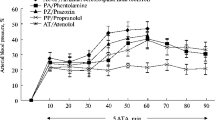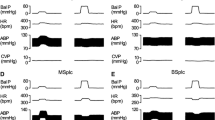Summary
Lumbricidae try to compensate for the permanent water loss during experimentally induced dehydration. InLumbricus terrestris L. this process is controlled by functionally coupled aminergic and peptidergic neurons of the central nervous system. It was shown (1) by electrocoagulation of well defined areas of the supra- and sub-oesophageal ganglion, (2) by transsection of the circumoesophageal connectives and commissures, and (3) by injection of reserpine into the coelomic cavity of the third and fourth segment, that there may be five different centers controlling water loss and compensatory processes acting after the loss. The greatest water loss was observed after destruction of areaA III of the suprao-esophageal ganglion. This region was built up of ependyma-like glial cells and rows of cilia of unknown origin. The possible role of these cilia as central receptor sites in the control mechanism of water balance inLumbricus terrestris L. is discussed.
Zusammenfassung
Im Dehydrations-Experiment versuchen Lumbriciden den permanenten Wasserverlust durch Gegenregulation zu kompensieren. Dieser Prozeß wird durch funktionell gekoppelte aminerge und peptiderge Neuronenkomplexe zentralnervös kontrolliert. Durch Elektrokoagulation bestimmter Areale des Ober- und Unterschlundganglions vonLumbricus terrestris L., Durchtrennung von Bahnverbindungen (Konnektive und Kommissuren) und Injektion von Reserpin wurden mindestens fünf verschiedene zentrale Regelglieder gefunden, die sich gegenseitig fördernd oder hemmend beeinflussen. Das übergeordnete Zentrum der Dehydrations-Kontrolle liegt im ArealA III des Oberschlundganglions, in dem zwischen ependymähnlichen Fasergliaformationen kettenförmig angeordnete Zilienquerschnitte beobachtet wurden. Eine Funktion dieser Zilien als zentralgelegene Rezeptor-organe des Regelsystems wird erwogen.
Similar content being viewed by others
Literatur
Bahl, K. N.: Studies on the structure, development and physiology of the nephridia of oligochaeta. VIII. Biochemical estimations of nutritive and excretory substances in the blood and coelomic fluid of the earthworm, and their bearing on the role of the two fluids in metabolism. Quart. J. micr. Sci.87, 357–371 (1947).
Bargmann, W.: Das neuroskretorische Zwischenhirn-Hypophysensystem und seine synaptischen Verknüpfungen. J. neuro-visc. Relat., Suppl.9, 64–77 (1968).
Drischel, H.: Beispiele, Ergebnisse und Perspektiven der Anwendung des kybernetischen Konzepts in der Medizin. In: Biokybernetik. (Drischel, H., Tiedt, N., eds.), Bd. I., S. 13–24. Leipzig: Karl-Marx-Universität 1968.
Falck, B., Owman, Ch.: A detailed methodological description of the fluorescence method for the cellular demonstration of biogenic monoamines. Acta Univ. Lund.2, No 7, 5–23 (1965).
Jackson, C. M.: Storage of water in various parts of the earthworm at different stages of exsiccation. Proc. Soc. exp. Biol. (N.Y.)23, 500–504 (1926).
Laverack, M. S.: Tactile and chemical perception in earthworms. I. Responses to touch, sodium chloride, quinine and sugars. Comp. Biochem. Physiol.1, 155–163 (1960).
—: The physiology of earthworms. Oxford-London-New York-Paris: Pergamon Press 1963.
Maloeuf, N. S. R.: The “metabolic gradient” in the adult earthworm. Z. vergl. Physiol.56, 429–436 (1936).
Myhrberg, H. E.: Monoaminergic mechanisms in the nervous system ofLumbricus terrestris L. Z. Zellforsch.81, 311–343 (1967).
Ogawa, F.: The nervous system of earthworms (Pheretima communissima) in different ages. Sci. Rep. Tohoku Univ.13, 395–488 (1939).
Oksche, A.: Unveröffentlichte Befunde.
Otremba, P.: Beobachtungen an neurosekretorischen Zellen des Regenwurms (Lumbricus spec.). Z. Zellforsch.54, 421–436 (1961).
Ramsay, J. A.: The osmotic relations of the earthworm. J. exp. Biol.26, 46–56 (1949).
Röhlich, P., Aros, B., Virágh, Sz.: Fine structure of photoreceptor cells in the earthwormLumbricus terrestris. Z. Zellforsch.104, 345–357 (1970).
Roots, B.: The water relations of earthworms. 2. Resistance to desiccation, immersion and behaviour when submerged and when allowed a choice of environment. J. exp. Biol.33, 29–44 (1956).
Scharrer, B.: Neurohumors and neurohormones. Definitions and terminology. J. neuro-visc. Relat., Suppl.9, 1–20 (1968).
Sitte, H.: Morphometrische Untersuchungen an Zellen. In: Quantitative methods in morphology (Weibel, E. R., Elias, H., eds.), p. 167–198. Berlin-Heidelberg-New York: Springer 1967.
Weibel, E. R.: Stereologioal principles for morphometry in electron microscopic cytology. In: Int. Rev. Cytol. (Bourne, G. H., Danielli, J. F., eds.), vol. 26, p. 235–302. New York-London: Academic Press 1969.
Wolf, A. V.: Studies on the behaviour ofL. terrestris and evidence for a dehydration tropism. Ecology19, 233–242 (1938).
Zimmermann, P.: Fluoreszenzmikroskopische Studien über die Verteilung und Regeneration der Faserglia beiLumbricus terrestris L. Mit Hinweisen auf die Struktur und Regeneration des neuresokretorischen Systems. Z. Zellforsch.81, 190–220 (1967a).
—: Methodische Modifikationen und eine neue Technik zur Darstellung des neurosekretorischen Apparates und der Neuroglia bei Wirbellosen (Lumbricus terrestris L.). Z. wiss. Mikr.68, 154–162 (1967b).
—: Beziehungen verschiedenartiger Zellkomplexe des normalen und regenerierenden Nervensystems vonLumbricus terrestris L. zum Gefäßsystem. Z. Zellforsch.106, 423–438 (1970).
Author information
Authors and Affiliations
Additional information
Herrn Prof. Dr. Dr. h. c. W. Bargmann, Kiel, gewidmet.
Mit Unterstützung durch die Deutsche Forschungsgemeinschaft.
Rights and permissions
About this article
Cite this article
Zimmermann, P. Die zentralnervöse Kontrolle der Dehydration beiLumbricus terrestris L.. Z.Zellforsch 112, 551–571 (1971). https://doi.org/10.1007/BF01033380
Received:
Issue Date:
DOI: https://doi.org/10.1007/BF01033380




